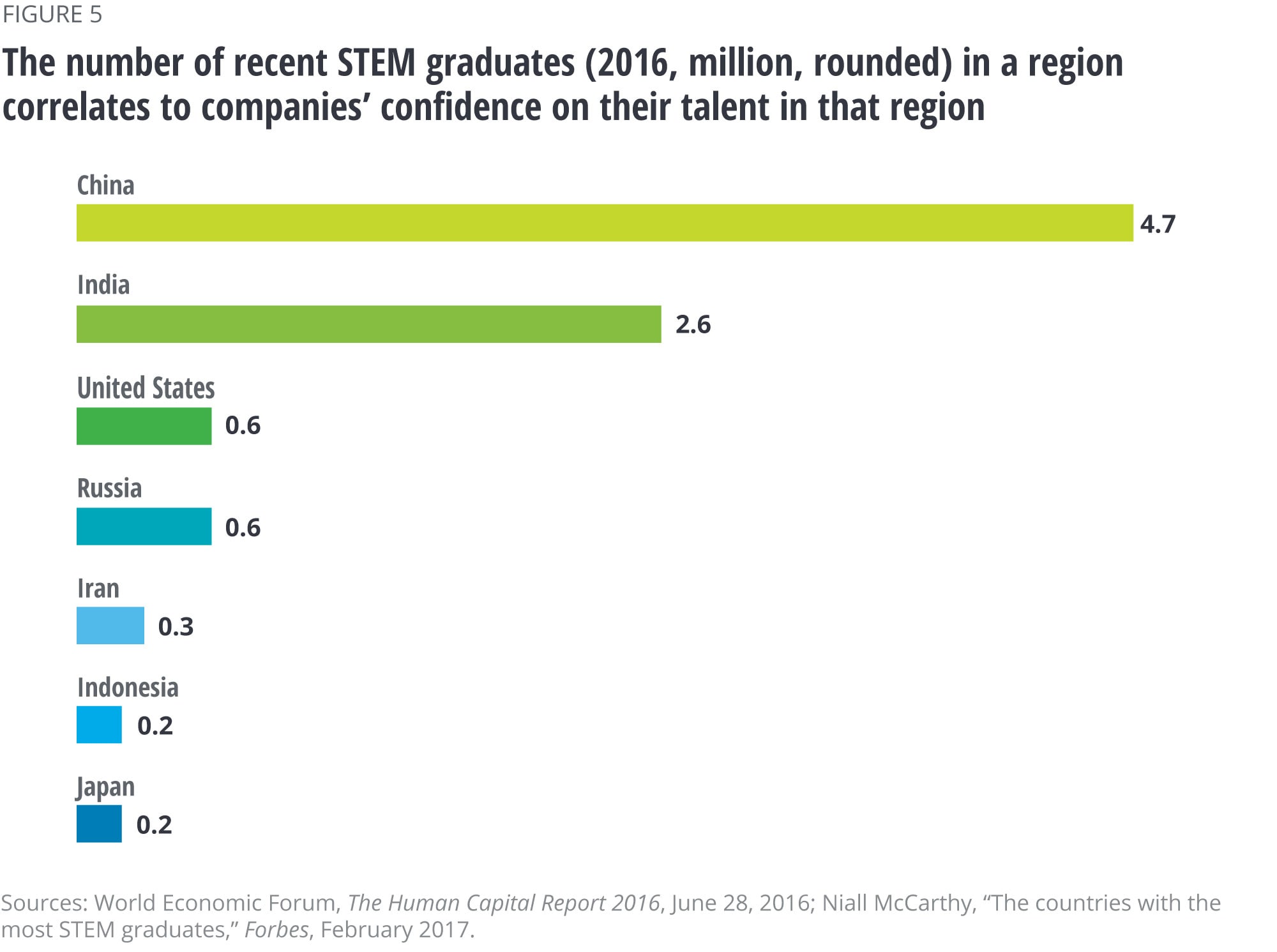
Distinctive traits of digital frontrunners in manufacturing Embracing the Fourth Industrial Revolution
23 August 2018
Manufacturers must achieve digital maturity across their broader enterprises. A Deloitte study of organizations that are taking the lead shows the steps needed to achieve digital maturity.
Thinking digital in Industry 4.0
The Fourth Industrial Revolution was born in the factory, marrying computer-programmed automation with digital technologies such as analytics, artificial intelligence (AI), and the Internet of Things (IoT) on the production line. Since its inception, Industry 4.0 has spread beyond the factory walls to encompass a broader digital transformation that spans processes, functions, and industries. This technology-driven transformation could change the way many organizations make sense of information and act upon it to make decisions that could impact operations, deliver greater customer value, and improve performance.1
Many industrial companies find themselves in a unique position regarding the Fourth Industrial Revolution. Despite their early lead implementing automation and computer programming in the factory and using technology to automate portions of supply chains, many manufacturers seem to be falling behind in adopting broader digital transformation initiatives that span the entire enterprise (figure 1). In an era where “disrupt or be disrupted” is fairly pervasive, limiting the digital strategy horizon to a few years and failing to advance along the digital maturity can increase the potential for being left behind.
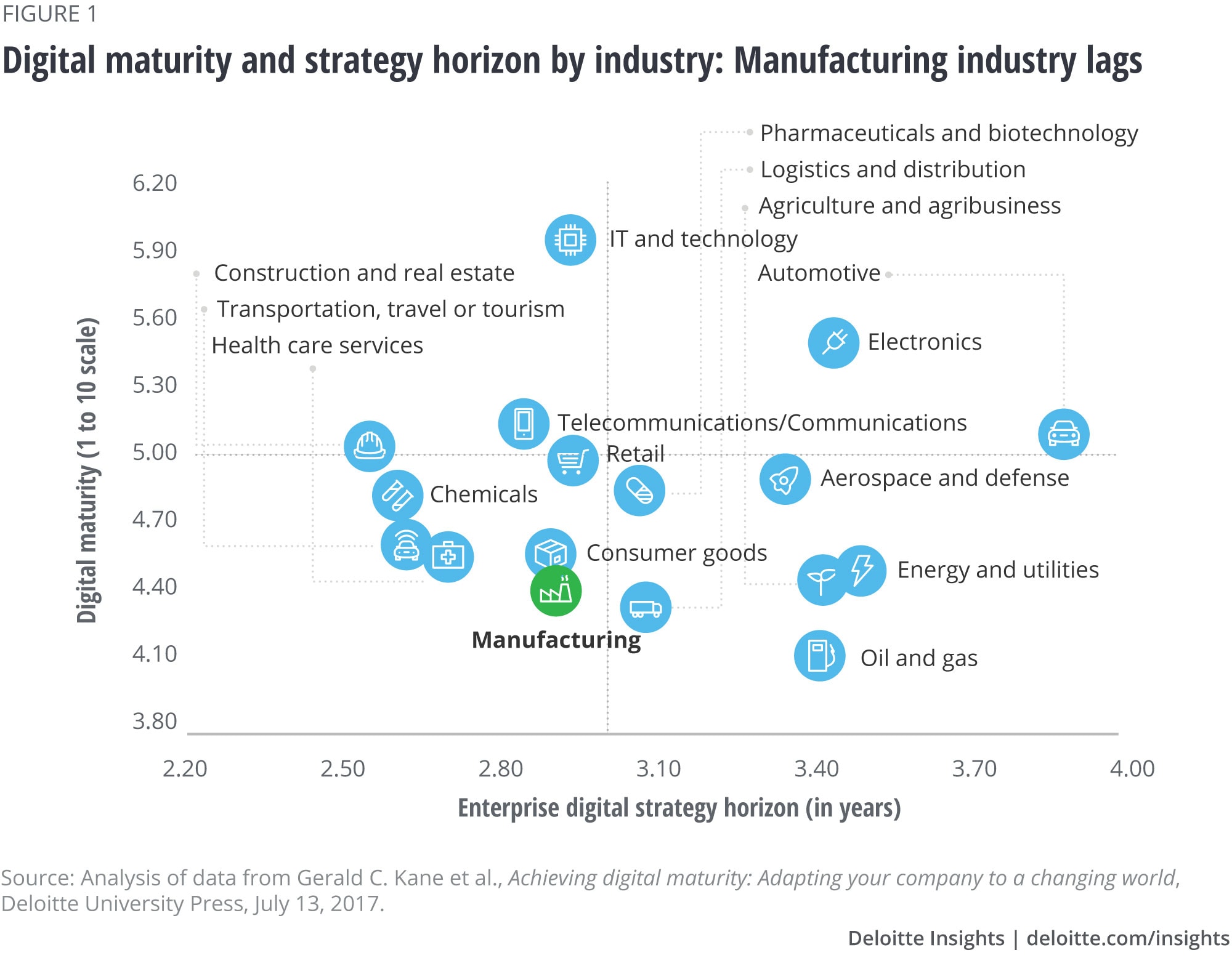
A recent global Deloitte Industry 4.0 study, The Fourth Industrial Revolution is here—are you ready?, sought to measure readiness for digital transformation across geographies and industries (see sidebar, “Methodology”).2 While the 1,600 executive respondents indicated a mix of opportunities and challenges surrounding the Fourth Industrial Revolution, there is a general sense of optimism in its ability to positively transform economies, business, and society. Along with this optimism regarding the potential for digital transformation to make a positive impact comes a reality that most organizations are far from reaching this stage. Overall, just 20.7 percent of manufacturing organizations surveyed rated themselves as “highly prepared” to address the emerging business models the Fourth Industrial Revolution brings.3
But there appears to be optimism. Analysis of the survey data identified a group of frontrunner organizations in manufacturing that are leading on the path toward digital maturity, as measured by not only their commitment to digital as the key ingredient to future business success but also their readiness to adopt advanced technologies.
Digital leaders in manufacturing: Taking a closer look
The move toward becoming a digital enterprise generally starts with successfully bridging the complex physical-digital-physical (PDP) loop, a hallmark of the Fourth Industrial Revolution. At its most basic, this complex cycle enables real-time access to data and intelligence throughout the business, giving actionable insights to operational leaders for making game-changing decisions. In manufacturing, this PDP loop has become common in the product life cycle, whereby developers create a “digital twin” of a physical product they are designing and then use real-time data and analysis to optimize the product design across a number of parameters before sending the product into production. The PDP loop has given rise to a move from linear supply chains toward digital supply networks (DSNs). DSNs are dynamic, integrated networks characterized by a continuous flow of information that facilitate automation, add value, improve workflow and analytics, and generate insights.5 A truly digital enterprise takes this DSN concept across all aspects of the business, including production, human resources, finance, sales and marketing, and customer service, creating PDP loops that continually show actionable business insights.
Technology is the underpinning of the digital enterprise, and the ability to understand the importance of technology and build a strategy that leverages advanced technology is a hallmark of leading manufacturers. In a Deloitte study, Exponential technologies in manufacturing: Technology, talent and innovation transformation in manufacturing, technologies from advanced robotics to IoT emerge as indispensable tools that accelerate the pace of transformation to digital enterprises.6 Although our research presents a clear and compelling case to leverage such technologies, a low adoption rate persists, with very few manufacturers operating in the “disruptive and nonlinear” transformation zone today.7
What are the keys to achieving digital transformation for manufacturers? Using the data from the global survey, our analysis identified two important characteristics of manufacturers leading the march toward digital transformation: a high understanding of the business value of new technology solutions and adoption readiness for those new technologies. Applying this construct to our cohort of manufacturing companies identified a set of frontrunners who are leading in the move toward digital maturity.
Specifically, companies can be divided into three conceptual segments based on how survey respondents rated the business value of new technology solutions and their enterprise’s readiness to adopt and use smart and autonomous technologies (figure 2):
- Frontrunners (26 percent) strongly believe in the business value of adopting new technology solutions for digital transformation and are ready to use the new technologies.
- Followers (51 percent) generally believe in the business value of new technology solutions, but lag on readiness.
- Stragglers (23 percent) are not yet on board with the business value of new technology solutions and are behind on adoption readiness.
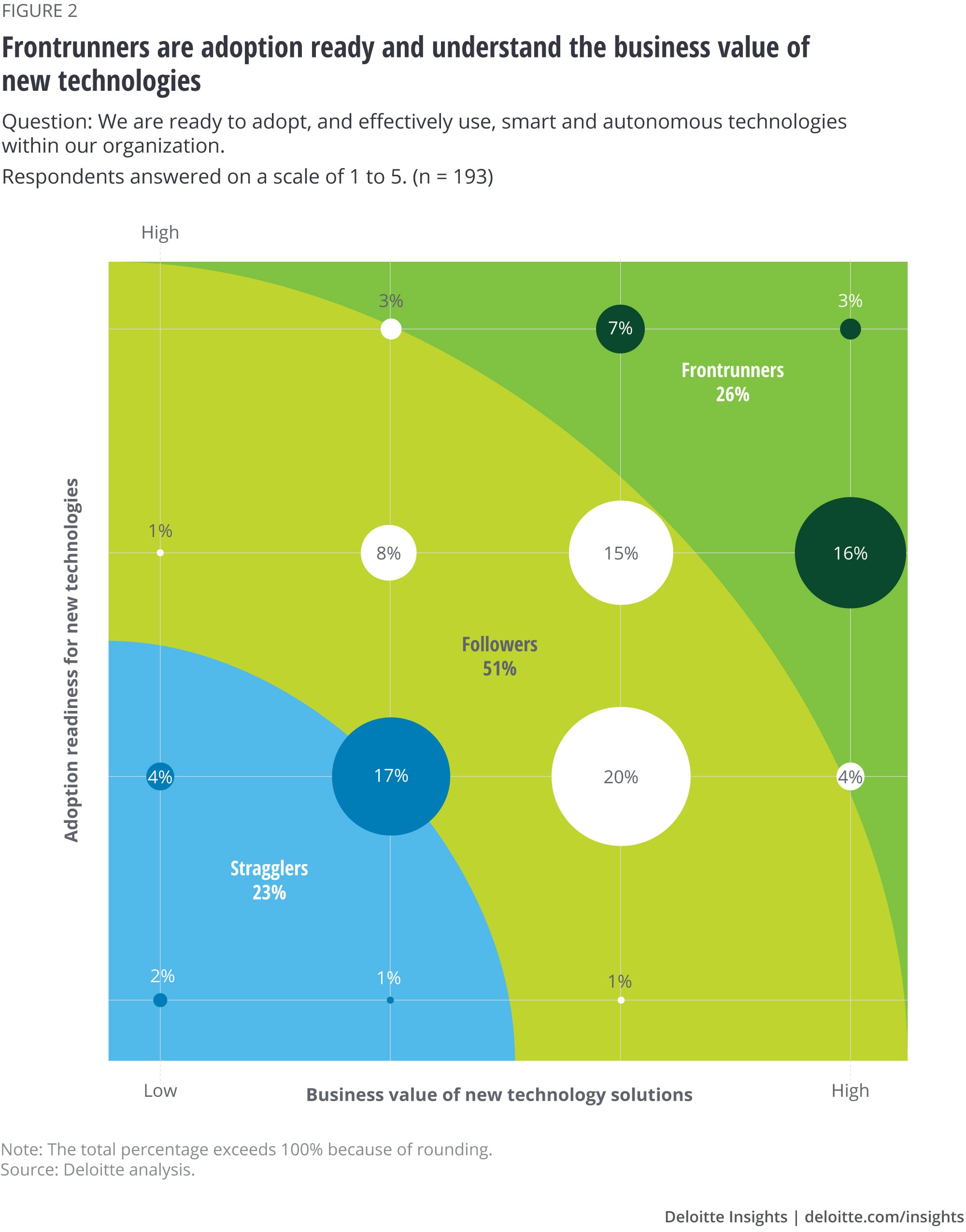
These frontrunners also have a higher confidence in their ability to outperform their competitors in a classic measure of delivering stakeholder value: delivering financial results. Based on survey results, frontrunners are 1.5 times more confident than stragglers in delivering strong financial results in the long term, reflecting their apparent ability to adopt new technologies that will transform the business.
What does digital readiness look like in manufacturing?
To further define how to embrace digital transformation throughout the business, we have identified four distinctive traits that most frontrunners exhibit that tend to make them digital leaders in manufacturing (figure 3).
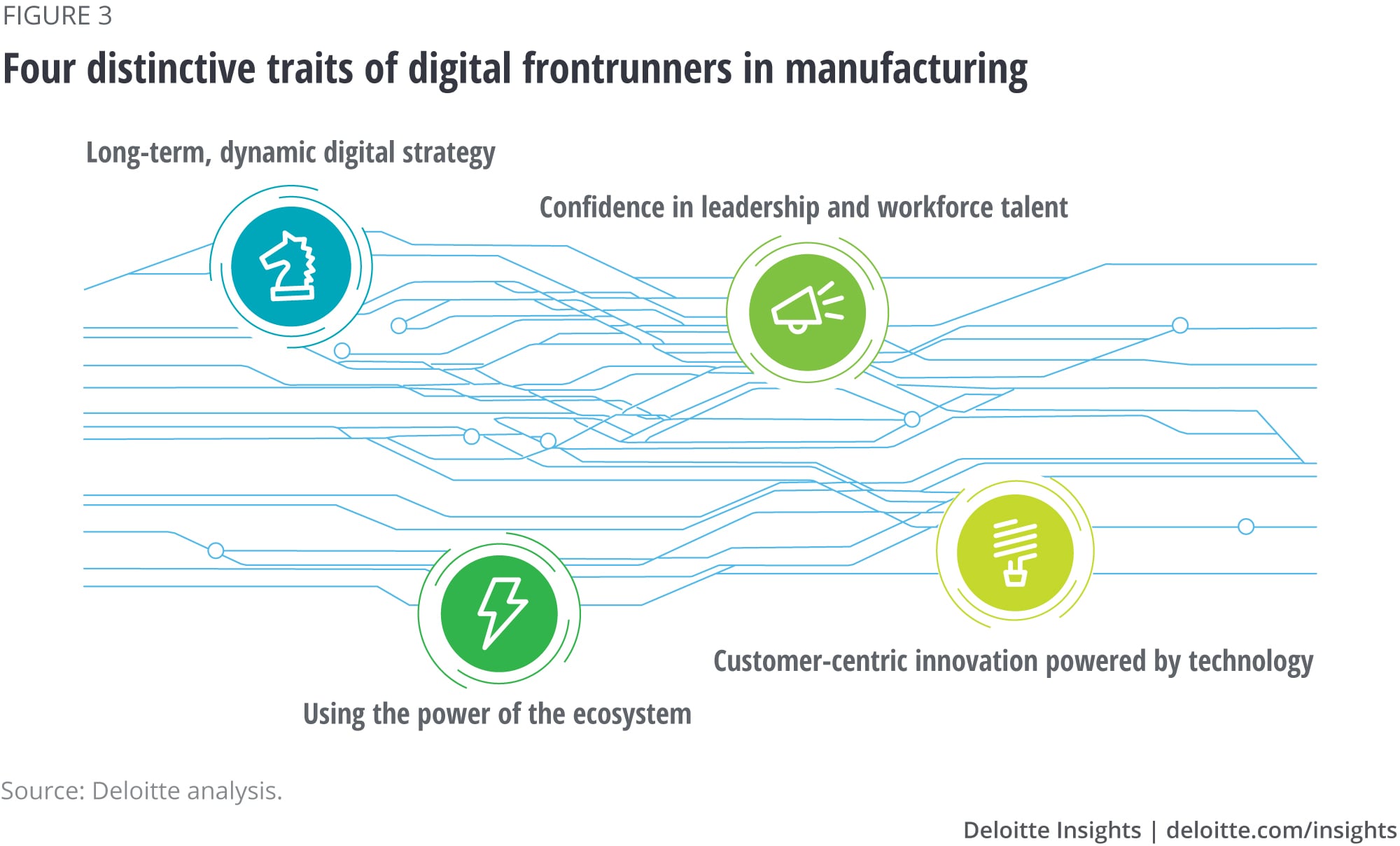
Adopting a long-term, dynamic approach to digital strategy
It is important to understand that digital transformation is a process, and not a binary switch. It typically requires organizations to create a digital strategy that is both incremental and dynamic, allowing for the inevitable shifts along the path as advanced technology discoveries continue and the marketplace changes. In fact, there is a strong argument for adopting a “data- and insight-centric approach” to digital transformation, one that can leverage underlying legacy technologies, but allow for application modernization as the company progresses toward digital maturity. This is a core capability of DSNs.9 Overall, all respondents identified the ability to integrate new technologies with what already exists in-house as the leading factor influencing their organization’s investment in advanced technologies.
Deere & Company, an American construction and heavy equipment manufacturer, is among the frontrunners in integrating innovative designs and solutions to its products. The company identifies innovation enabled by technology and data analytics along with connecting machines with people, technology, and insights as critical to success. Deere & Company has built smart, connected products with features such as satellite guidance and live data monitoring. The data is collected through sensors and pulled into a cloud for analysis, thereby helping customers make informed decisions. Through a web platform, the company is also able to remotely diagnose machines in the field and help its customers with predictive maintenance, thereby reducing downtime. Through digital innovation at the core, Deere & Company has been able to provide sustained value to its customers.10
Notably, the paths diverge when comparing frontrunners’ investment reasons with followers’ and stragglers’ choices. Frontrunners look to technology’s long-term impact and they care how that technology will increase customer satisfaction/engagement.11 Both factors reflect a broader view of how advanced technologies are part of a long-term digital strategy, one that is in lock-step with customer needs to maximize business results and deliver customer value. Frontrunners were nearly two times more likely to connect investments in advanced technologies to increasing customer engagement than stragglers. In contrast to the “long-term impact,” stragglers were four times more likely to invest in technologies based on their ability to show “quick wins.” Nonetheless, this short-term approach is limiting, and can stand in the way of digital maturity.
Using the power of the “ecosystem”
Part of the promise of the Fourth Industrial Revolution is the creation of new ecosystems that could drive value in novel and disruptive ways. The combination of advanced manufacturing with increased connectivity and the shift toward an information-based economy seem to create an imperative for manufacturers to identify how they will expand their ecosystems to thrive.12 Our study explored several ways in which many companies pursue beneficial relationships that contribute to an ecosystem approach, with frontrunners outpacing stragglers in several key areas (figure 4). Frontrunners tend to move quickly on digital initiatives by bringing in the resources needed to advance them. They are twice as likely as stragglers to outsource a specific task to their ecosystem until they can build expertise internally.
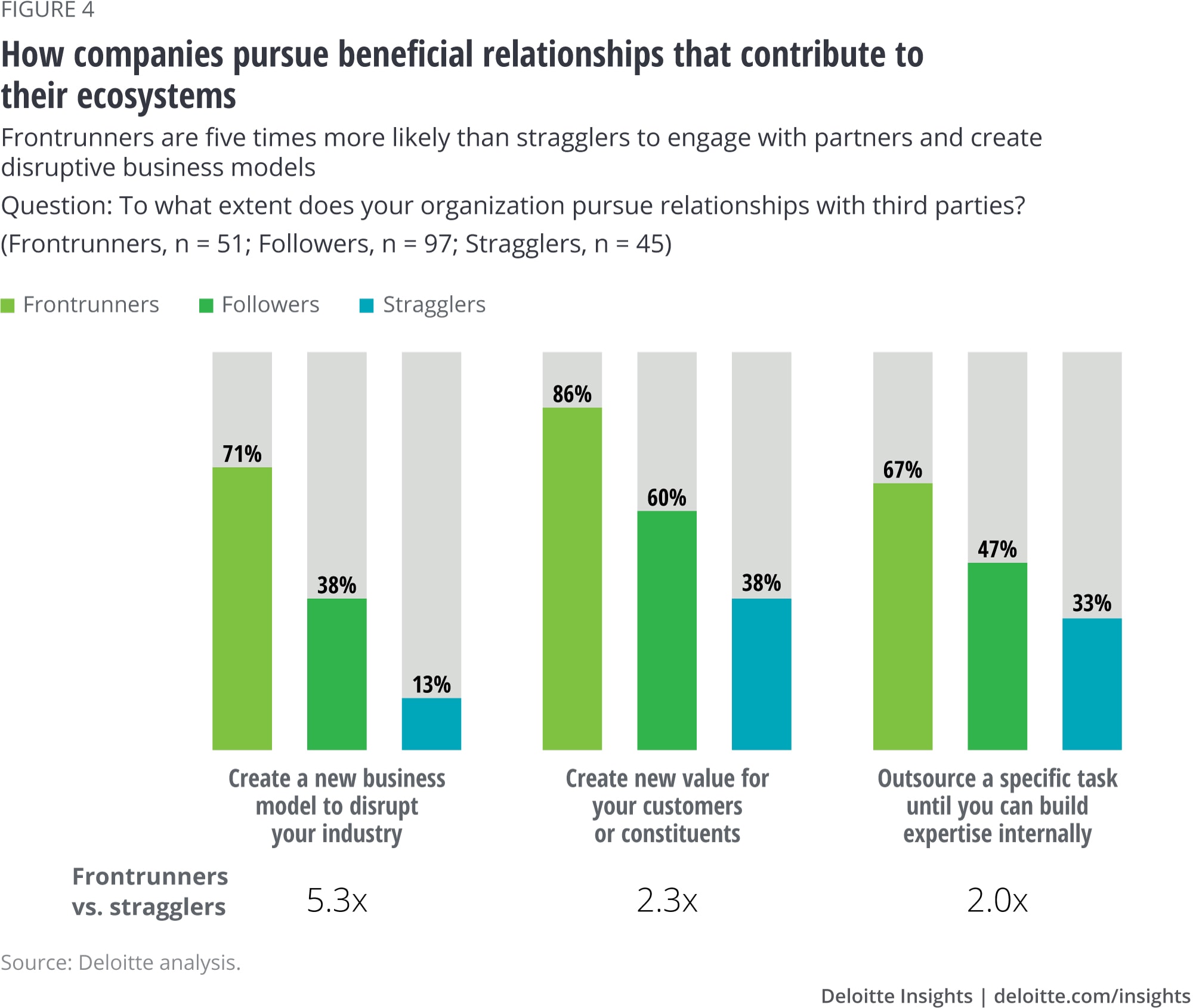
Frontrunners also are 2.3 times more likely than stragglers to seek out ecosystem relationships that create new value for customers according to survey results. And, 82 percent of frontrunners assert they are “very” or “highly” capable of mobilizing a larger and more diverse ecosystem of participants to deliver value to their customers. Forging connections that amplify the impact on customer experience is typically important. It can also naturally merge into another aspect of ecosystem relationships: finding disruptive ways to combine information (from products, processes, customers) with technology (algorithms, machine learning) to create new business models. Survey results revealed that frontrunners are five times more likely than stragglers to create new business models that disrupt their industry. The upside of this potential could be enormous, as manufacturers that are capable of leveraging the ecosystem can achieve growth in new ways, such as Boeing investing in Morf3D (a California-based 3D-printing startup) to enhance product design and manufacturing processes by using additive manufacturing.13 Similarly, Siemens, through its Frontier Partner Program, partners with Silicon Valley startups to focus on additive manufacturing and robotic technologies.14
Gaining from capable leadership and preparing talent for digital transformation
Beyond the impact that the Fourth Industrial Revolution is having on partnerships, ecosystems, and customer value creation is its impact on the workforce, which must adapt in the face of advanced technologies, shifting business models, and digital transformation. As our report The digital supply network meets the future of work suggests, in the coming years almost all work will likely involve people working alongside technology or robots they are not currently working with today.15 And, contrary to many predictions that machines will replace the human labor force in the coming years, historically technology creates more jobs than it destroys.16 The new jobs it creates, however, are often drastically different than their predecessors, requiring different skill sets. The changes this would require in the current workforce in manufacturing could be far-reaching, and in many cases, may not even yet fully understood, as widespread adoption of advanced technologies is just beginning. Therefore, manufacturers should prepare accordingly. But how?
Mitsui & Co. Ltd., a global industrial products conglomerate, focused on leadership and talent to enable and drive its digital transformation strategy. It created a new role of the chief digital officer (CDO) to drive companywide precedence in digital transformation initiatives. The new CDO set up a digital transformation strategy team consisting of existing employees from the company’s business innovation department and Mitsui Knowledge Industry Co. Ltd. as well as new employees with specialization in digital and cybernetics. The digital transformation team works to identify business opportunities by applying AI capabilities to existing data and by using IoT to drive factory automation, predict system failures, increase efficiency, and forecast supply and demand.17
The results of the global study, with 1,603 respondents across industries, suggest there is not a clear path forward in executives’ minds for planning for and addressing the effects that technology-driven changes have on their employees.18 However, frontrunner manufacturers were found to have higher confidence in their ability to address these changes than overall respondents—82 percent of frontrunners believe they are “very” or “highly” capable of absorbing the changes to come, and 64 percent are confident that, while their workforce doesn’t yet possess the right skill sets, they can successfully train their talent in digital skills. Part of this confidence may stem from the fact that the manufacturing industry has been absorbing advanced technologies for many years, since the dawn of the Third Industrial Revolution in the 1970s, which brought electronic automation to the production process. What remains important for these frontrunners, and all manufacturers, is to build preparedness into their talent management efforts, including reskilling programs that incorporate digital skills.
Making technology investments that drive customer-centric innovation
At the heart of the Fourth Industrial Revolution is the marriage of digital information from a multitude of sources with the physical act of manufacturing. A common term for this marriage is information technology and operational technology integration.19 And, as the phrase demonstrates, technology is the instrumental enabler of becoming a digital enterprise. Study results reveal that frontrunner manufacturers have a keen understanding of how new technologies will alter their delivery of products and services. Sixty-five percent of frontrunners understand technology’s role in their transformation, compared with only 29 percent of stragglers. Frontrunners have more than a casual relationship to the advanced technologies driving the Fourth Industrial Revolution. Often, the technology is supporting another important attribute of leading digital enterprises: delivering customer-centric value through innovation.
Airbus, a global aerospace and defense company, uses digital innovation to enhance value for its customers. “Skywise,” an open-data platform created by the company, enables its customer to seek support of 20,000 Airbus engineers throughout the lifespan of an aircraft. This platform offers features such as fleet analysis, efficiency monitoring, and predictive maintenance along with data analytics tools to minimize fuel consumption. Airbus’s customer-centric innovation has resulted in more than 12 airlines and 2,000 aircrafts connecting to its digital platform.20
Part of the urgency surrounding the move toward digital enterprises is the tangible fear of being disrupted in the market by both traditional competitors and new entrants from other industries. This increases the pressure on most manufacturers to constantly innovate around products and services. Our study results revealed that frontrunners are adept at translating technology into innovation that delivers customer value. Seventy-three percent of frontrunner manufacturers feel they are very capable of redefining customer relationships through technology. And 92 percent of frontrunners have high confidence in their ability to deliver the best possible products and services to customers. Often these products and services reflect the digital capabilities of the Fourth Industrial Revolution, namely transforming the data generated by machines into value-added intelligence and new offerings.21 Placing the customer at the center of innovation is important for manufacturers, and most frontrunners are embracing this practice.
Manufacturing companies can use the Fourth Industrial Revolution to transform into digital enterprises
The rise of the Fourth Industrial Revolution is expected to bring with it tremendous change, technologies that have the power to impact all aspects of the business, and an increased pressure for manufacturers to transform or risk extinction. Possibly never before has the need to do something seemed so pronounced. Analysis of survey data has revealed the difference between those manufacturers that are embracing technology by acknowledging its business value and are ready to adopt, and those that still lag in digital maturity. While overall the market is still fluid and there is time to respond to the disruption that these advanced technologies bring, the window appears to be closing for stragglers. These companies are still struggling to understand where to play in newly emerging technology ecosystems, and they should identify the necessary technologies that could define how to win.22 The frontrunners should not let their guards down as the Fourth Industrial Revolution is rapidly evolving. They should continue to identify and integrate evolving digital elements in their strategy. The following recommendations may prove helpful for frontrunners, followers, and stragglers:
- Hone your digital strategy: At this point, most manufacturers should be finalizing their digital strategy and, in some cases, already executing against defined goals. To succeed, ensure there are short-term projects with measurable return on investment that tie into longer-term “big wins” that have the potential to redefine the way an organization delivers value to the market.
- Talent and workforce: As one of the biggest potential stumbling blocks for digital transformation in manufacturing, getting talent right could be critical. Invest in identifying how your workforce might need to change in the face of digital transformation. This may involve building scenarios for the skill sets that will be necessary in five and 10 years, and working backward to develop training programs in addition to new recruitment tactics that align to the scenarios.
- Technology: Advanced technologies can accelerate the pace of transformation in your organization. Rather than starting with a business process that is “broken,” apply advanced technology like AI and robotic process automation to a business process that is functioning well because the positive results will likely build trust and demonstrate the efficacy of technology in a well-understood business area.
- Value creation: Digital strategy creates new growth opportunities as smart connected products enable a deeper understanding of the customers. Prioritize and invest in technologies that add value to and enhance the customer experience. A more engaging and value-driven experience for customers is likely to help forge long-term relationships with them.
Tactical, need-based digital efforts can reap immediate, short-term gains, but they can also slow the overall pace of digital maturity. Building a digital core and developing a strategy guided by a digitally fluent leadership team that is ready and willing to make targeted technology and talent investments could create value, unlock untapped market potential, and bring in competitive advantage.
© 2021. See Terms of Use for more information.


